By Stephanie Namahoe Launiu
Celebrated on the first of May, May Day in Hawai‘i is a vibrant expression of island culture and aloha spirit. While many cultures mark May 1 with springtime traditions, Hawai‘i has created a celebration uniquely its own — centered around the beauty of lei-making, music, and hula.
Across the islands, schools, communities, and cultural groups come together in colorful displays of floral artistry and dance, honoring both nature and heritage. At its heart, May Day in Hawai‘i is a joyful reminder of the connection — between people, the land, and the rich traditions that continue to thrive today.

The City and County of Honolulu Department of Parks and Recreations, in conjunction with the Hawai‘i Tourism Authority, holds the largest public celebration with its Annual Lei Day gala at Kapi‘olani Park Bandstand in Waikīkī.
This celebration happens May 1 each year regardless of the day of the week. This year (2025) marks the 97th anniversary of Honolulu’s Lei Day Celebration.
This is the premier event showcasing the skill and talent of Hawai‘i’s lei makers. In particular, the lei contest always attracts exquisitely crafted lei using a wide variety of materials, styles, and colors.
Lei makers submit their fresh flower lei for the contest between 7:30 a.m. and 9 a.m. on the morning of the event. Following the lei judging, the public can view the submissions and winning lei contest exhibit from 1 p.m. to 4:45 p.m.
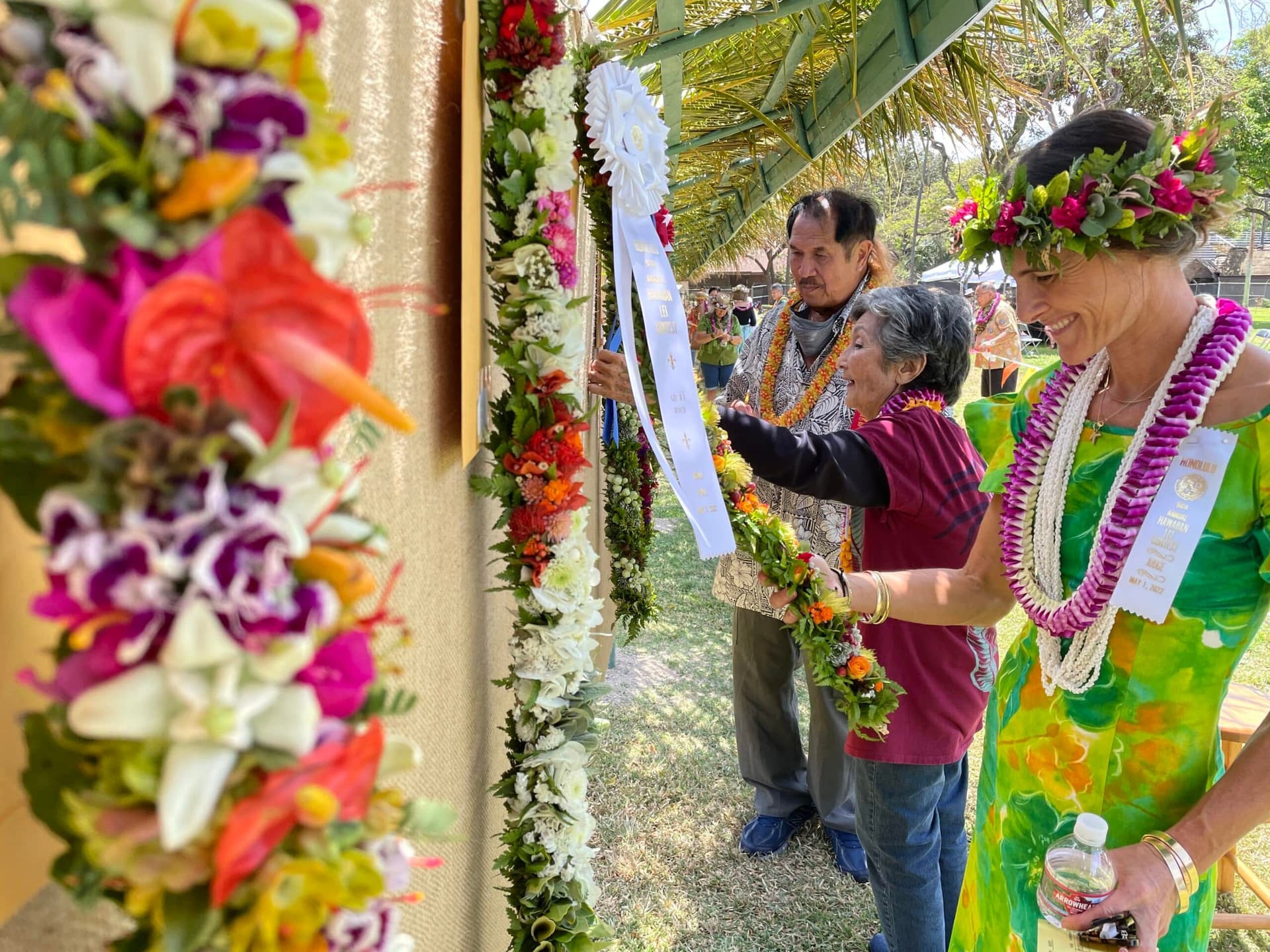
The lei queen and her court are on hand to meet the public. In addition, the day includes Hawaiian entertainment, hula hālau performances, food, craft, and vendors.
After the event ends, the flower lei from the contest are taken to Mauna ‘Ala (The Royal Mausoleum) and Kawaiaha‘o Church where they are placed on the graves and tombs of Hawai‘i’s ali‘i (chiefs and royalty).
Learn how to grow your own lei flowers.
Don Blanding came to Hawaiʻi from Oklahoma in 1915. Before that, he had seen a play called “The Bird of Paradise,” which was a romantic, but untrue, story about Hawaiʻi. Upon arrival in the islands, he began writing newspaper ads for Ajinomoto Foods and eventually became a successful author and artist.
In 1927, Blanding and a fellow Honolulu Star-Bulletin writer named Grace Tower Warren came up with the idea of honoring Hawaii’s lei, which they thought to be in decline at the time. Warren came up with the catchy tagline that has been around for almost a century, “May Day is Lei Day.”
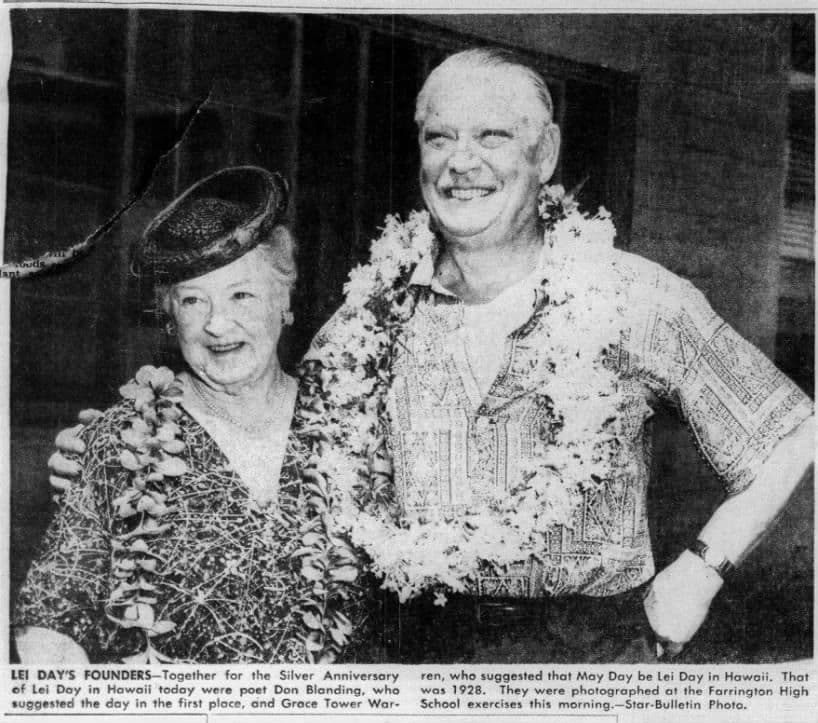
The first Lei Day was held on May 1, 1928, and was a rousing success. It took place in the Bank of Hawaiʻi lobby and the official judges were:
Princess Abigail Wahiikaahuula Campbell
Elizabeth Lahilahi Webb (lady-in-waiting for Queen Liliʻuokalani)
Aliʻi Lucy Kalanikiʻekiʻe Davis
The leis were judged for the maker’s use of flowers and island colors as designated in 1923 by Hawaiʻi’s Territorial Legislature.
Each island is symbolized by a flower and a color:
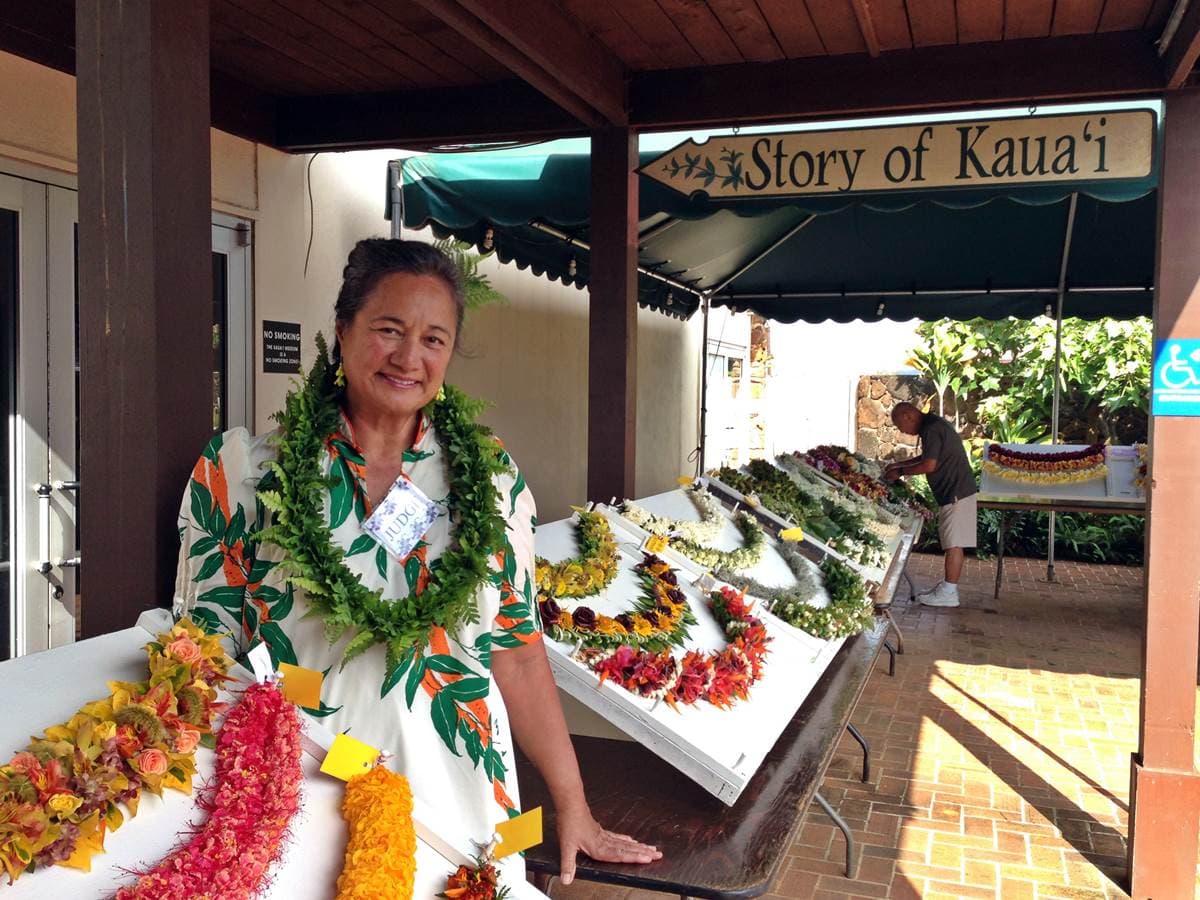
Irmalee and Walter Pomroy founded the Kaua‘i Museum’s (4428 Rice St., Līhu‘e) May Day lei contest, a celebration of traditional lei-making that continues today. Irmalee was named a “Living Treasure” in 2002 for her cultural contributions. The museum hosts the annual contest and offers lei-making classes year-round.
Learn More about the Kaua‘i Museum.
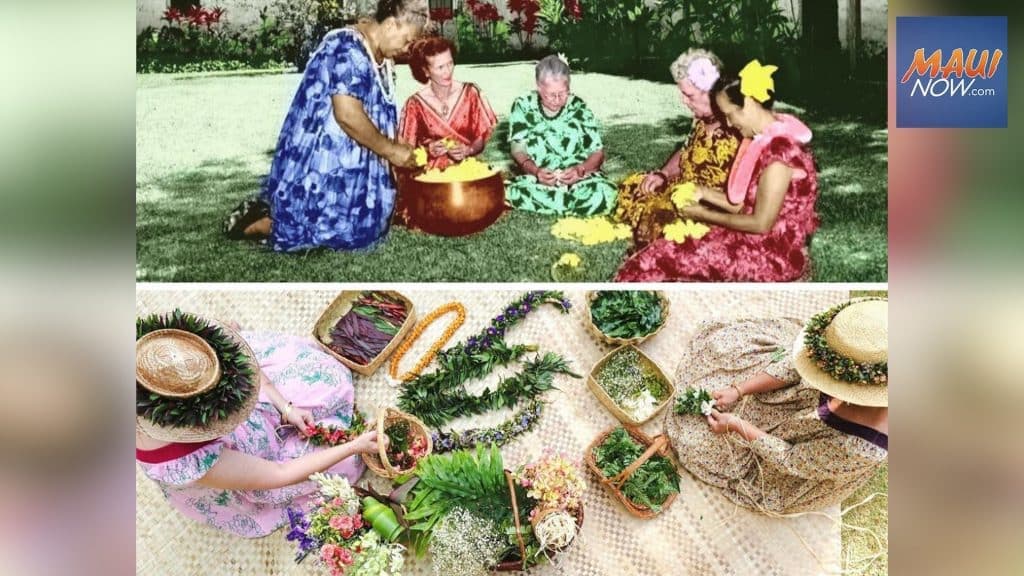
The Maui Historical Society sponsors an annual Lei Day Heritage Festival at the Hale Hō‘ike‘ike at the Bailey House (2375A Main St., Wailuku) in Wailuku. Guests can participate in lei-making workshops, enjoy live Hawaiian music, and view the beautiful lei contest submissions.
Find out more about the Lei Day Heritage Festival here.
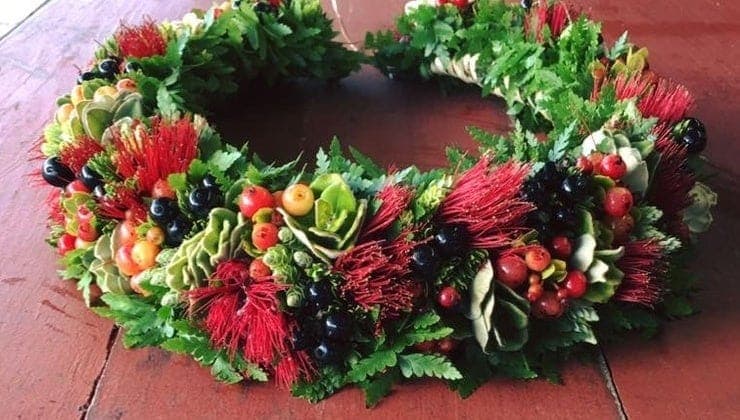
Kalākaua Park (136 Kalākaua St, Hilo) is the site for the annual Lei Day celebration on the Big Island. Music, hula, a lei contest, and lei-making workshops are always part of the fun.
Hilo native Kuana Torres Kahele, an entertainer and master lei maker, lends his knowledge to the community. The photo above is an example of one of his gorgeous Hawaiian haku lei. Haku is a method of lei that weaves flowers, leaves, and plants into a braid. Lei po‘o, worn on the head, is a representation of haku.
See Kuana Torres Kahele teach lei-making in this video.
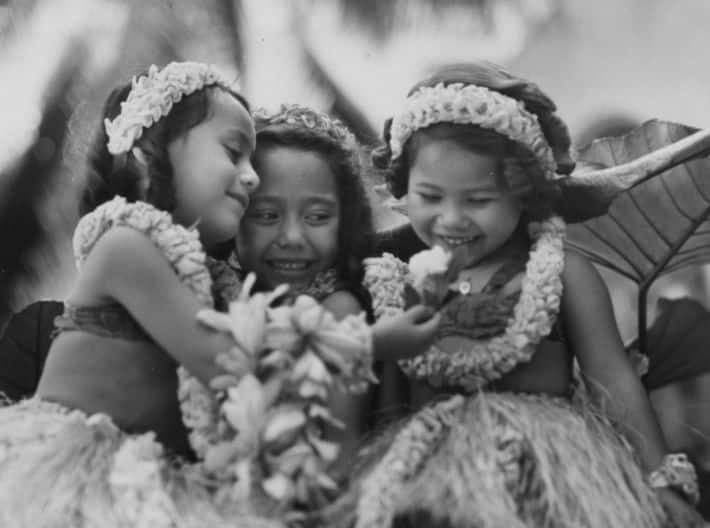
Children have been an important part of Lei Day since the beginning. (Photo Credit: Kamehameha Schools)
Nearly every school in Hawai‘i hosts a Lei Day program that includes hula performances, traditional dress, and a Lei Day Court honoring Hawaiian royalty. These celebrations teach keiki the values of aloha, respect, and unity through song, dance, and cultural pride. May Day is one of my favorite school memories when parents and grandparents come to watch, and every student has a part to play.
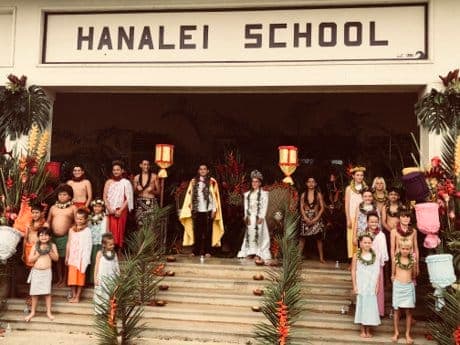
Hula is at the heart of Lei Day. Both traditional hula kahiko and modern hula ‘auana performances bring Hawaiian legends, nature, and love stories to life. Accompanied by oli (chanting) and live music, hula is more than just dance — it’s a celebration of identity, storytelling, and spirit.
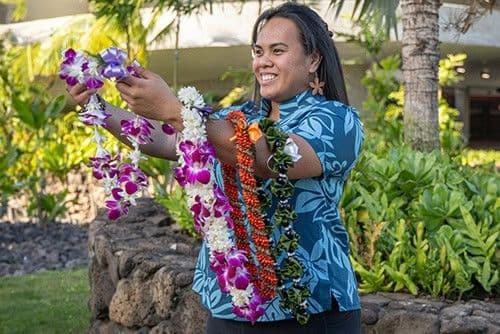
A lei is a sign of aloha. (Photo credit: Ah Loe Leis)
Lei Day is a celebration of aloha — the Hawaiian values of compassion, connection, and respect. Giving or receiving a lei is a personal gesture of love or welcome, often shared with a hug or kiss on the cheek.
Crafting a lei takes intention, patience, and a deep respect for nature — qualities that reflect the heart of the Hawaiian worldview.
Organizations like the Bishop Museum and the Office of Hawaiian Affairs (OHA) help keep Lei Day traditions alive through education and community outreach. Most importantly, hālau hula (hula schools) continue to host Lei Day events, passing knowledge and tradition to the next generation.
Even social media has a role — sharing images, chants, and hula performances with a global audience. Through these platforms, cultural appreciation extends beyond the islands.
Discover how the Office of Hawaiian Affairs works to support the well-being of Native Hawaiians.
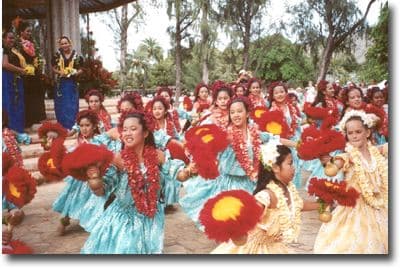
Hula dancers at Kapi’olani Park in Waikiki. (Photo credit: County of Honolulu)
Lei Day is inclusive and celebrates the mosaic of cultures that call Hawai‘i home. Everyone is welcome to participate, learn, and embrace the meaning of aloha and the cultural symbolism of the Hawaiian lei. You’re part of the ohana (family) on Lei Day. With hula, music, flowers, and aloha at its core, it’s a reminder to pause, honor the past, and connect with each other.
Join our newsletter for travel inspiration, insider tips and the latest island stories.
By subscribing, you agree to receive emails from Hawaii.com. You can unsubscribe anytime. See our Privacy Policy.